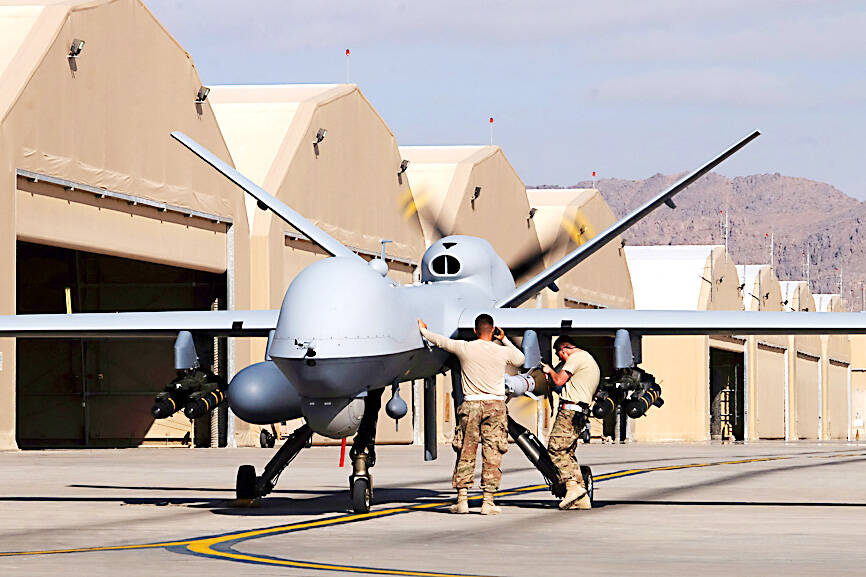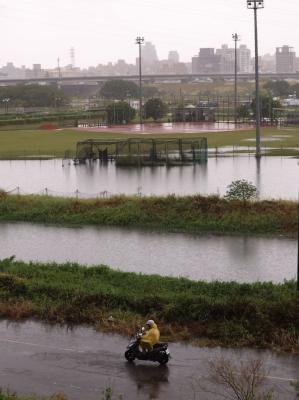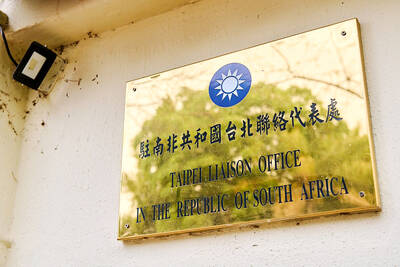The US’ US$345 million military aid package for Taiwan announced late last month would include four MQ-9A reconnaissance drones, a military source said yesterday.
Washington is still working on removing some of the more advanced and sensitive components of the drones, so there is no set delivery date, the source said on condition of anonymity.
The US$345 million aid package also includes training programs and ammunitions for Taiwan’s military, the source added.

Photo: Reuters
Asked about the source’s comment, the Ministry of National Defense said that it could not provide further details of the aid package to honor the US-Taiwan agreement.
Lin Ying-yu (林穎佑), an assistant professor at Tamkang University’s Institute of Strategic Studies, had earlier said that the drones would significantly boost Taiwan’s overall intelligence, surveillance and reconnaissance capabilities, as they can swiftly pass receive intelligence to logistics units via a satellite link.
Taiwan also purchased four MQ-9B “Sea Guardian” drones from former US president Donald Trump’s administration for US$217 million, with delivery expected in 2025.
The US announced the US$345 million military aid package for Taiwan on July 28, which is to be delivered under a Presidential Drawdown Authority (PDA) approved last year by the US Congress and permits up to US$1 billion of weapons aid to be sent to Taiwan in fiscal 2023.
The PDA enables the US president to direct a drawdown to provide military assistance to US allies in crisis situations.
It allows for the speedy delivery of defense articles and services from the Pentagon’s existing stock to foreign countries and international organizations to respond to “unforeseen emergencies,” the US Department of State said.
However, since last year, Taiwan has been highlighting delays in the delivery of weapons it has purchased from the US.

Taipei, New Taipei City, Keelung and Taoyuan would issue a decision at 8pm on whether to cancel work and school tomorrow due to forecasted heavy rain, Keelung Mayor Hsieh Kuo-liang (謝國樑) said today. Hsieh told reporters that absent some pressing reason, the four northern cities would announce the decision jointly at 8pm. Keelung is expected to receive between 300mm and 490mm of rain in the period from 2pm today through 2pm tomorrow, Central Weather Administration data showed. Keelung City Government regulations stipulate that school and work can be canceled if rain totals in mountainous or low-elevation areas are forecast to exceed 350mm in

EVA Airways president Sun Chia-ming (孫嘉明) and other senior executives yesterday bowed in apology over the death of a flight attendant, saying the company has begun improving its health-reporting, review and work coordination mechanisms. “We promise to handle this matter with the utmost responsibility to ensure safer and healthier working conditions for all EVA Air employees,” Sun said. The flight attendant, a woman surnamed Sun (孫), died on Friday last week of undisclosed causes shortly after returning from a work assignment in Milan, Italy, the airline said. Chinese-language media reported that the woman fell ill working on a Taipei-to-Milan flight on Sept. 22

COUNTERMEASURE: Taiwan was to implement controls for 47 tech products bound for South Africa after the latter downgraded and renamed Taipei’s ‘de facto’ offices The Ministry of Foreign Affairs is still reviewing a new agreement proposed by the South African government last month to regulate the status of reciprocal representative offices, Minister of Foreign Affairs Lin Chia-lung (林佳龍) said yesterday. Asked about the latest developments in a year-long controversy over Taiwan’s de facto representative office in South Africa, Lin during a legislative session said that the ministry was consulting with legal experts on the proposed new agreement. While the new proposal offers Taiwan greater flexibility, the ministry does not find it acceptable, Lin said without elaborating. The ministry is still open to resuming retaliatory measures against South

1.4nm WAFERS: While TSMC is gearing up to expand its overseas production, it would also continue to invest in Taiwan, company chairman and CEO C.C. Wei said Taiwan Semiconductor Manufacturing Co (TSMC) has applied for permission to construct a new plant in the Central Taiwan Science Park (中部科學園區), which it would use for the production of new high-speed wafers, the National Science and Technology Council said yesterday. The council, which supervises three major science parks in Taiwan, confirmed that the Central Taiwan Science Park Bureau had received an application on Friday from TSMC, the world’s largest contract chipmaker, to commence work on the new A14 fab. A14 technology, a 1.4 nanometer (nm) process, is designed to drive artificial intelligence transformation by enabling faster computing and greater power